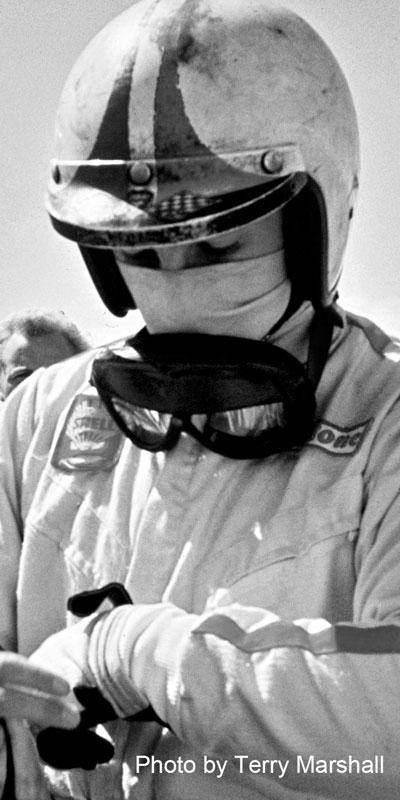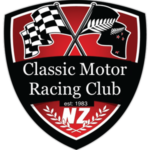ORIGINS

Classic Racing Motor Racing Club was started in 1983 by a group of classic enthusiasts who had cars no longer suitable for serious competition events.
The objects of the Club are:-
(a) To promote and organise racing and speed events at suitable venues for the members of the Club.
(b) To encourage the restoration, preservation and use of historic racing cars and Racing Sports Cars (whether raced in New Zealand or not), also N.Z. Historic Specials (whether Sports or single seater) and genuine factory performance versions of saloons at the discretion of the V.A.C.
Download a full copy of the CMRC Club Rules.
An extract from 'Skidding the Tyres in Classic Style':
The late Eileen McMillan authored a comprehensive history on the club. Limited copies of the book are still available for sale.
Page 11:
At the beginning of the 1980s, the first muted engine blips of classic and historic motorsport almost completely failed to signal the full-throated roar of popularity that was to eventuate over the next two decades.
The Vintage Car Club of New Zealand (originally the Vintage Vehicles Association) had been around since early 1946. VCC eligibility was generally based on age rather than any notion of quality or performance. By 1983 the VCC admitted vehicles manufactured up to 1958. Categories existed for accepting more modern racecars if no longer in production, but racecars tended to be relatively rare in that club, not least because there was little opportunity to give them an outing.
While a few VCC branches such as Otago, Banks Peninsula and Waitemata held regular hill climbs and other speed events, there were then, as today, many members who abhorred such competition as potentially destructive of historic machinery.
Of the one-make clubs, only a few such as the MG Car Club had a membership sufficient to muster a competitive race grid. In the North Island, the Thoroughbred And Classic Car Owners' Club (TACCOC) and the Historic Racing And Sports Car Club were providing race meetings, but for a fairly select and thus limited number of vehicles.
This left a whole range of cars, not necessarily stunning in appearance or performance but nevertheless far from run of the mill, that had nowhere to go for the kind of low-key speed events that one club in particular had been providing for its members since its inaugural meeting in 1975.
The Country Gentlemen's Historic, Racing and Sports Car Club (named, one must suppose, with tongue somewhat in cheek) comprised a small group of performance car and motorcycle enthusiasts who sought to exercise their exotic vehicles occasionally in suitable locales where speed and a degree of sportsmanlike competition would not mean breaking the law or bending panels.
Safety briefings at these gatherings were deceptively simple. All race winners were announced before racing began, and any driver even suspected of unsporting behaviour would find his racecar back on the trailer and himself being shown the exit gate with barely time for him to remove his crash helmet. The Country Gents not only possessed desirable and interesting vehicles.
The Country Gents had Contacts. The Gents could somehow arrange the occasional use of tempting circuits such as the Wigram Aerodrome in Christchurch, seldom available for motorsport other than the Lady Wigram Trophy events.
The Gents made no pretence of democracy. If they deemed you to be the proper sort of chap with a proper sort of car (or motorcycle), you might be invited to their race meetings. If you were not invited, there was little you could do about it. Any pressure on the Gents to extend their range of 'acceptable' vehicles was largely ignored.
The Country Gentlemen's Historic, Racing and Sports Car Club was thus one of the most mouth-watering and sought after of motoring organisations, and one of the most exclusive. (Politically correct readers may be interested to learn that, questioned regarding the status of `Gentlewomen' in this club, CG co-founder Allan Bramwell would remark that women could be honorary Gents if they had a decent car and could drive well enough.
Over the years a number of women, including the author, have accepted Honorary Gentship.) The eligibility issue inevitably came to a head as more and more car owners sought to become involved in low-key, non-professional motorsport.
The Country Gents were widely felt to be unduly restrictive. On the other hand, the Country Gents' founders were growing increasingly concerned that their original aims were becoming diluted and standards lowered. Good grief, next they would be asked to accept Japanese cars! Although formal incorporation had been considered at the Country Gents' December 1982 AGM for primarily financial reasons, there was still widespread shock when, unannounced, in early 1983 the original fifteen 'Gents' themselves incorporated their club, effectively excluding all other members.
Country Gents events were thenceforth even more strictly 'invitation only.' And a growing group of eager drivers abruptly found their access to classic racing effectively whipped from beneath their wheels.
So it was that on Sunday 31 July 1983, about fifty people from as far away as Christchurch and Invercargill gathered at 11 am for a 'Special General Meeting of Former Country Gents Historic Racing and Sports Car Club members' in the Leisure Lodge Motor Inn, Dunedin.
Under the chairmanship of the Immediate Past Chairman of Country Gents, Andrew Cunningham (deposed without warning by the CG incorporation four months earlier), they considered the recommendations of a Steering Committee formed in March 1983 to look at proposed articles of a new club, provisionally named The Classic Racing Car Club of New Zealand Incorporated.
Those present at that meeting felt that the suggested title might be taken to imply the exclusion of sportscars, though these were likely to make up the majority of club vehicles. The group also wished to be free, as did the Country Gents, to cater for motorcycles, although the motorcyclists were also to investigate forming their own register and rules. The new club's name was finalised as The Classic Motor Racing Club of New Zealand Incorporated (CMRC). It too was duly registered as an incorporated society on 8 August 1983.
Officers elected to that first CMRC committee were: President — Stuart Barclay; Secretary — Graeme Currie; Treasurer — Ralph Smith; Immediate Past President [of Country Gents] — Andrew Cunningham; Legal Advisor — Russell Duell; Auditors — Kendon Cox & Co. Vehicle Eligibility Committee members elected were Brian Middlemass (Queenstown), Ray Larsen (Invercargill), Malcolm McMillan (Dunedin), Brian Morris (Timaru) and Peter Read (Christchurch). All former members of the Country Gents were deemed at that point to be financial members of the new Classic Motor Racing Club. It was hoped that those members would remain and participate in the CMRC's events. It was also believed that the CMRC could co-exist and co-operate with the Country Gents Club. Indeed, on the very first Calendar of Events considered at that meeting, one of the three listed dates was a Country Gents invitation event on Wigram Aerodrome. As anticipated, the two clubs have independently thrived and co-operated ever since.
